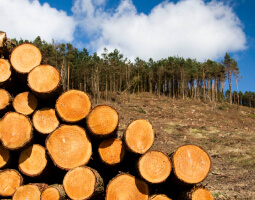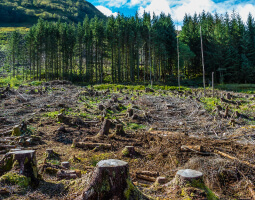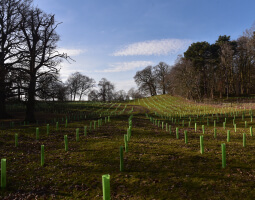Climate Change Impacts on Soil Carbon
Forest soils provide essential functions including water infiltration and purification, providing nutrients for forest growth, supporting biodiversity and storing carbon. Soils can store up to 70% of forest carbon (Vanguelova et al., 2013) and play an important role in climate change mitigation. This page provides an overview of how climate change can influence forest soil carbon stocks, both directly and indirectly.
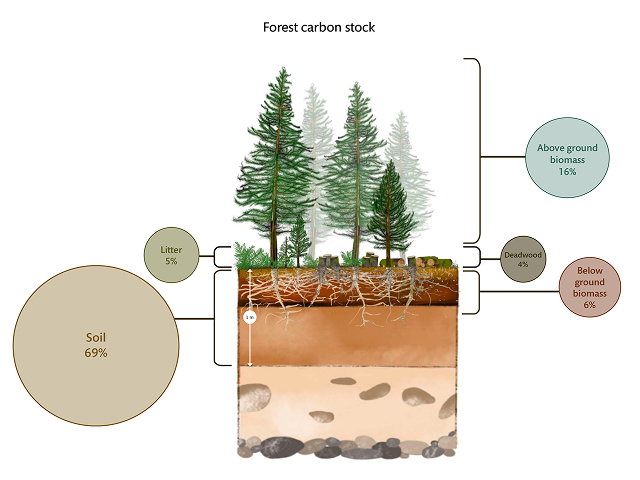
Click image to enlarge.
Figure 1. Illustration of the relative proportions of where carbon is stored in the forest, based on Forestry Statistics 2024.
How much carbon is in forest soils?
As trees grow, they absorb or ‘sequester’ carbon dioxide from the atmosphere and turn it into organic matter in the form of leaves, branches, roots and stems. The carbon that is retained in the long-lived woody material in trees and woodlands, or in harvested timber helps to limit the rise in atmospheric greenhouse gases that is driving climate change.
Less well known is that the soil beneath the trees contains more carbon than in the trees themselves and soils contribute substantially to the global carbon balance. Depending on soil type, in the UK on average two to three times more carbon is held in soil organic matter than is present in the trees above ground, but the proportion can be even higher for organic, peaty soils.
How much carbon is in forest soils?
Approximately three quarters of the 1095 million tonnes of carbon estimated to be stored in UK forests and woodland, resides in the soil. The amount of carbon held in different soil types (‘soil carbon stock’) decreases from organic > organo-mineral > mineral soils. The size and significance of the soil carbon stock means that forest owners and managers have an important duty of care to protect this key resource, which is also critical in soil health and fertility.
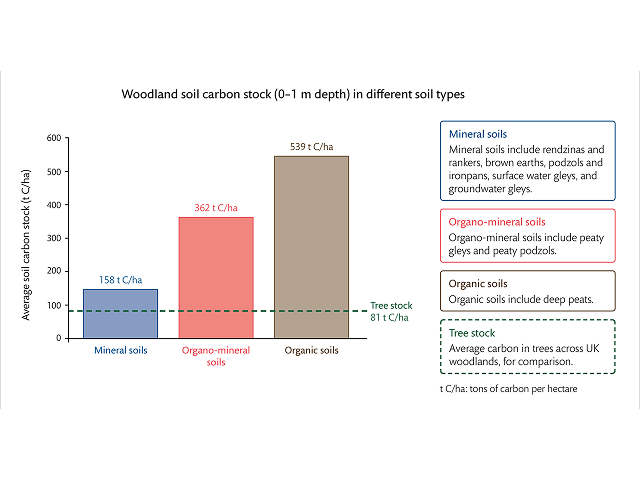
Click image to enlarge.
Figure 2. UK woodland soil carbon stock by soil type. Source: Soil carbon data – BioSoil survey 2005-2008, ICP Forests. Tree carbon data – Forestry Statistics, 2022.
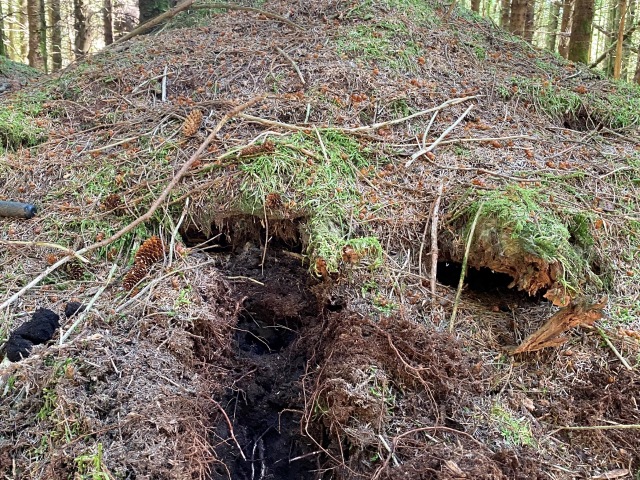
How can the changing climate impact forest soil carbon?
Soil organic matter is the most important soil component, as it influences soil structure, water holding capacity, soil stability, nutrient storage and turnover and oxygen availability, properties that are fundamental in maintaining and improving soil quality.
A decline in organic matter content increases the likelihood that water and nutrient supply for tree and other vegetation growth is limited as well as increasing the susceptibility to soil erosion. The carbon stock in forest soils represents a balance between additions from plant organic material (above and belowground, including exudates from roots) and other microbial organic material and losses by decomposition, leaching and erosion over time.
These processes are strongly affected by climate, especially temperature and moisture, as well as by the nature of the soil, geology and landform. Climate warming is likely to accelerate the decomposition of soil organic matter, but this could be countered by inputs of litter in the form of foliage, woody material and roots to the soil and if there is increased tree growth. Therefore, climate change can influence forest soil carbon both directly and indirectly:
Direct effects
Direct effects arise from changes in temperature and moisture regimes, which affect microbial activity, soil organic matter decomposition rates and plant growth. As temperatures rise, microbial activity generally increases, leading to faster decomposition of organic matter and potentially resulting in a net loss of soil carbon to the atmosphere as CO₂. Shifting precipitation patterns—whether prolonged droughts, more intense rainfall, or changes in seasonality —affect soil moisture and can alter oxygen availability, which influences the balance of aerobic versus anaerobic microbial processes resulting in changes to carbon cycling. Areas with warmer temperatures and less rainfall will have less soil moisture, which may restrict tree growth and reduce decomposition, affecting the forest carbon balance.
Indirect effects
Indirect effects occur through tree and understory vegetation changes, altered nutrient cycles, and disturbances. For example, warming may facilitate the northward expansion of certain tree species or encourage invasive pests and pathogens to spread, changing litter input quality and quantity. Disturbances, such as more frequent wildfires, extreme storms, flooding, or insect outbreaks, can decrease vegetation biomass, disrupt soil structure, and accelerate soil carbon losses. Over time, these complex interactions tend to reduce the long-term stability and storage of carbon in forest soils unless the losses are offset by enhanced productivity that increases carbon inputs to the soil.
How vulnerable are forest soil carbon stocks to climate changes?
Forest soil carbon stocks can be resilient to changing conditions but are certainly not immune to the extensive and extreme climatic changes. Their vulnerability depends on factors such as the initial soil carbon content, soil type, climate regime, forest species composition, and the complexity of below-ground biodiversity and food webs.
Regional factors
In northern regions like Scotland and in the uplands, a large amount of soil carbon is currently stored in relatively stable forms due to low temperatures, higher water tables and slow microbial activity. As these regions warm and/or the soil water table is lowered, large amounts of previously stable carbon may become vulnerable to rapid decomposition and release.
In southern and lower elevation regions, higher temperatures and altered rainfall patterns may change the type and amount (stock) of soil carbon. However, increased vegetation growth in some locations—stimulated by longer and warmer growing seasons and/or the increasing atmospheric CO₂ concentration and nitrogen deposition – could partially offset soil carbon losses by increasing litter and root inputs and turnover. The net effect depends on the balance between enhanced decomposition and potentially increased inputs. The vulnerability of the soil carbon stock is, therefore, context-dependent and can range from relatively stable in some well-managed or moisture-rich systems to highly susceptible to losses in regions experiencing rapid warming, drying, and disturbance.
Soil types
The carbon stocks of some soil types are more vulnerable than others, with deep peat most at risk due to both the nature and quantity of carbon. Deep peat contains 3-4 times more carbon than in mineral soils just in the first 1 m (and much more if there are deeper peat deposits). This represents 11% of the total UK forest soil carbon stock.
The type of soil organic matter is another important factor, with the stability of different organic compounds varying from days (e.g. microbial material) to hundreds or even thousands of years (e.g. charcoal). The texture of the soils plays a crucial role in the stability of carbon in mineral soil types, with clay soils containing most of their carbon in a stable form compared to sandy soils, where it is held in less stable forms.
Forest design and tree species choice
Forest design and tree species choice also have important roles in soil carbon, as they will result in different inputs and quality of organic matter into the soil, which determine the speed of breakdown processes and the proportion of organic matter that remains in the soil or that is released from the soil as CO₂. In particular, choice of appropriate tree species and mixtures well suited for the soil conditions and site characteristics will reduce vulnerability to climatic changes, because they are more likely to continue to provide carbon inputs to the soil.
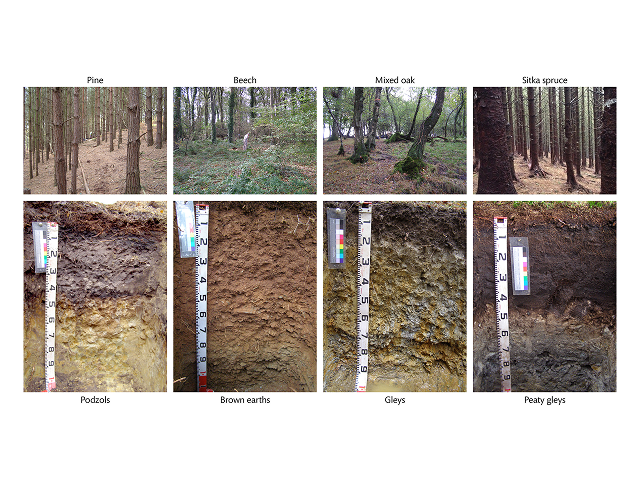
Click image to enlarge.
Case study: The Scottish Forest Alliance project
The Scottish Forest Alliance project was an ambitious native woodland establishment project involving 14 locations in Scotland, with a 200-year legacy. Forest Research provided both independent scientific advice and rigour regarding carbon protocols, and services including carbon modelling to assess and validate carbon stocks both above ground and in the soil. This video emphasises the importance of soil carbon when forecasting and measuring carbon in woodlands and forests.


